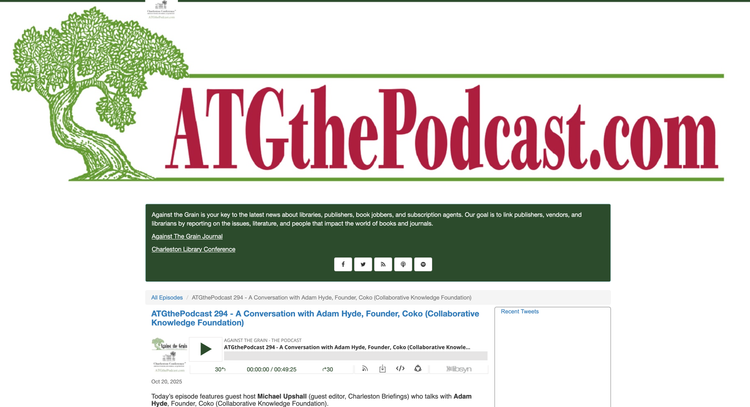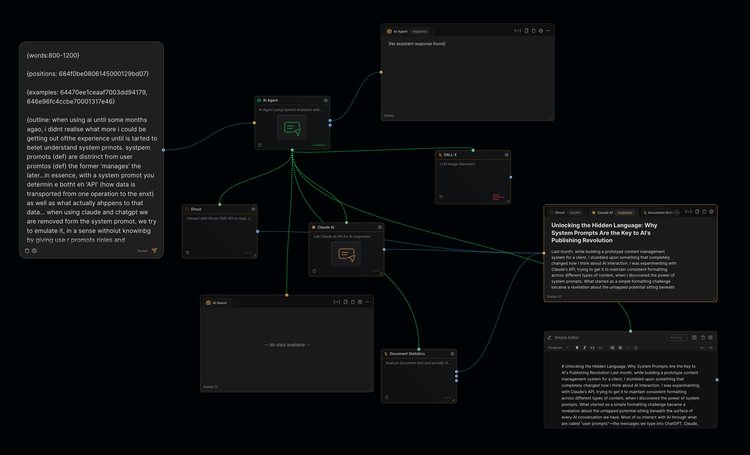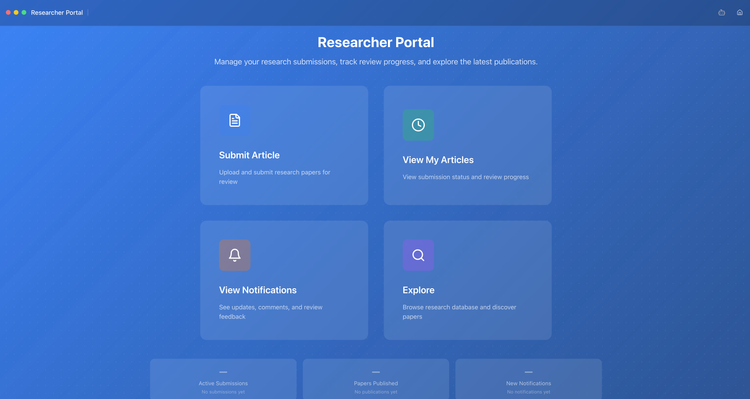CMS Strategies for Scholarly Publishing: A Hybrid Approach

Scholarly publishing has evolved alongside technology, with many software systems available today to manage both article delivery and website content. Some systems, like Janeway and Open Journal Systems (OJS), integrate workflow and publishing into a single platform. Others, like PubPub, focus solely on publishing, leaving workflow management out of the equation. In the proprietary world, you’ll find similar divides between workflow-focused platforms and content management systems (CMSs).
At Kotahi, we initially chose a split approach, focusing on building a robust workflow engine while separating the CMS functionality. This allowed us to prioritize efficient workflow management—a task that took us several years to refine. However, about a year ago, we realized we needed a integrated CMS to streamline the full process and enhance the publishing experience.
Enter FLAX, a static website generator built on 11ty. FLAX is a powerful tool that gave us the ability to shape how published objects—be it a preprint, journal article, or data publication—are presented. Unlike GUI-based CMSs, which often impose structural limitations, FLAX uses text templates that offer immense flexibility. For a platform like Kotahi, which must accommodate a wide variety of published artifacts, this flexibility is crucial.
Yet, while FLAX is excellent for structuring and presenting published content, it became clear that managing an entire website (such as about pages, news, contacts, and subscriptions) through a template-driven system is an arduous task. This realization led us to a new, hybrid strategy.
Our solution, developed in close collaboration with Paul Shannon from eLife, is to split responsibilities between FLAX and a GUI-based CMS, such as WordPress. In this model, FLAX continues to manage the presentation of the published artifacts, while (for example) WordPress handles the rest of the website's content management.
The Reverse Proxy Strategy
To make this hybrid system seamless, we are using a technical solution known as a reverse proxy. Essentially, a reverse proxy is a server that sits in front of the WordPress and FLAX servers, directing requests based on the URL. For example, requests to http://somedomain.com/articles/ would be routed to FLAX, while all other requests would go to WordPress.
By maintaining consistent design aesthetics across both systems—and synchronizing the same menus across both platforms—the user won’t notice any difference between the two systems. The site will appear unified, even though it’s being served by two separate technologies.
Navigating Challenges
There are a few initial challenges to solve for this approach. The first is maintaining synchronized navigation across both systems. We don’t want to manually update the menus in both FLAX and WordPress every time there’s a change. To solve this, we are developing a WordPress plugin that allows FLAX to read the WordPress menu and update itself automatically.
The second challenge is ensuring WordPress has the latest information about published articles. Site content and article content are often closely linked, so WordPress needs to know what articles are available, their categorization, abstracts, and so forth. To manage this, the same WordPress plugin will evolve to provide this data to WordPress, enabling features like "latest articles" to be dynamically displayed on the homepage.
In the future, we’ll be working on integrating article references into WordPress in a more automated way. This will allow editors to easily reference specific articles via autocomplete of URLs/titles etc when writing news updates or commentary without needing to manually copy and paste URLs.
The Best of Both Worlds
Ultimately, this hybrid strategy provides the best of both worlds: an infinitely malleable front-end for displaying any kind of published research object through FLAX and a user-friendly, feature-rich CMS (WordPress) for managing the rest of the website. It’s a flexible, powerful solution that combines technical flexibility with user-friendly management tools, giving scholarly publishers the tools they need to handle both structured content and web presence efficiently.
Why WordPress?
WordPress is an excellent choice for this strategy because of its ubiquity and maturity. It currently powers around 43% (861 million sites) of all websites on the internet, reflecting its many years of development and reliability. One of its greatest strengths is the vast ecosystem of plugins and extensions available, far beyond anything offered by existing publishing platforms. These plugins cover a wide range of functionalities—from SEO optimization and analytics to e-commerce and advanced forms—making WordPress a highly versatile tool for web management.
WordPress is also incredibly easy to use, making it simple for publishers and organizations to manage their sites without needing extensive technical expertise. Its intuitive interface allows even non-technical users to make changes, and the platform supports a multitude of drag-and-drop page builders that drastically simplify the design process. If you haven’t looked at WordPress recently, you might be surprised by how user-friendly it has become for site building. WordPress has largely become a 'no code' platform, meaning you don't have to know PHP (the language WP is written in) to changes the layout and design. Essentially you can do a lot just with drag and drop features similar to Squarespace and other modern systems. The big advantage of course being that WP is open source so if you want to go the extra mile in customization you can do it with a developer.
On that note, WordPress boasts the largest availability of developers and designers in the world, meaning you can easily find support for customization, design tweaks, and building custom extensions. This abundance of talent, combined with an enormous wealth of documentation, ensures that you’re never far from a cost effective solution to any problem or a way to extend your site’s capabilities.
WordPress is also incredibly cost-effective for hosting. It is free to use and cheap to self-host, with options for reliable hosting starting at as little as $4 per month. This makes it an affordable solution for publishers looking to manage their site without excessive overheads.
We are currently working with both traditional publishers and emerging groups who don’t necessarily define themselves as publishers but are looking to share different types of research objects, such as data publications, preprints, reviews, and more. For both categories, the ease of use and customization in WordPress offers significant time and cost savings.
In short, WordPress provides professional-grade tools at a fraction of the cost of bespoke solutions, with a flexibility and extensibility that existing scholarly publishing systems simply can't match. Major organizations, from The New Yorker to TechCrunch and BBC America, use WordPress to manage their vast, high-traffic sites, proving its scalability and robustness.
Rethinking Scholarly Publishing CMS Needs
The scholarly publishing sector has historically been a bit “snowflakey” when it comes to publishing solutions, preferring to use 'publishing specific' tools. While bespoke publishing solutions are certainly necessary for managing scholarly workflows, the same is not true for website content management—despite what many might think..
This hybrid strategy demonstrates that leveraging existing open-source infrastructure like WordPress in innovative ways can provide immense value. By combining the malleable, template-driven capabilities of FLAX with the user-friendly and extensible nature of WordPress, scholarly publishers can achieve the best of both worlds: a powerful, cost-effective solution that meets the unique needs of scholarly communication while also benefiting from the scale and polish of one of the most widely used CMS platforms in the world.
However, this strategy is not limited to WordPress. The ‘split content concerns’ approach—where FLAX handles the structured, published artifacts, and another CMS manages the rest of the site—can be extended to other CMS options. Platforms like Squarespace, Drupal, or even other static site generators could be coupled with FLAX to achieve the same flexible and powerful setup. This ability to use any CMS with Kotahi gives emergent models and established publishers alike enormous flexibility to choose the CMS that best suits their needs and budget, whether it’s ease of use, customization potential, or the availability of existing plugins and integrations.
It's important to recognize that CMS platforms are mature web commodities. There’s no need to build or maintain something from scratch, nor is there a need to use a 'publishing-specific' solution for content management. CMS systems like WordPress, Drupal, and others have already solved the general challenges of web management. Rebuilding a CMS for the publishing sector is not only unnecessary but also a waste of resources. These existing platforms are maintained by vast, active communities and are continually improved and updated—allowing scholarly publishers to focus on what they do best rather than reinventing the wheel.
Instead of reinventing the wheel for every part of scholarly publishing, we should focus on integrating and adapting existing, open-source infrastructure wherever possible—making it work for us. This approach is not only more flexible but also cost-effective and leverages the best of both worlds: the power of specialized, dynamic content platforms and the vast, mature CMS ecosystem.
© Adam Hyde, 2024, CC-BY-SA
Image public domain, created by MidJourney from prompts by Adam.






Member discussion